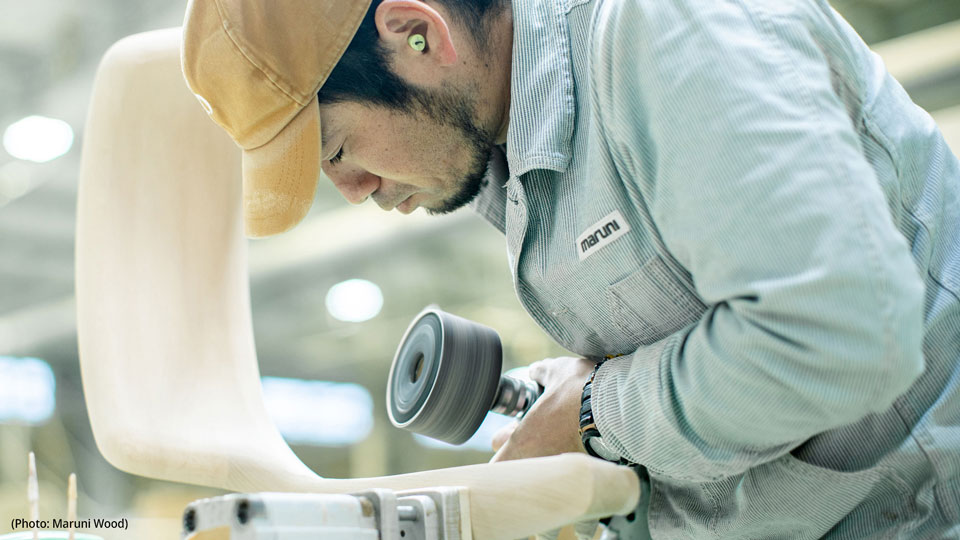Agency of Industrial Science and Technology, Japan
In the late 1950s polyacrylonitrile (PAN) carbon-fiber, a material consisting of extremely thin acrylic fibers mostly made out of carbon atoms, was developed at Japan’s former Government Industrial Research Institute, Osaka (GIRIO), which was the Kansai (the mid-western part of Japan) regional branch of the Agency of Industrial Science and Technology (AIST). Although GIRIO no longer exists in name (it was renamed AIST Kansai in 2001), it formed an important part of a Japanese research organization that has been contributing to Japan's technological advancement since 1876.

GIRIO was – and continues to be under the AIST Kansai name – Japan’s second largest research base. Established in 1920 as a public research institution, GIRIO was founded to provide technical guidance to various industries in the Kansai region, especially to small and medium-sized enterprises (SMEs). GIRIO’s early research efforts placed an important emphasis on the textile industry, and as such the development of carbon fiber was of particular interest to the organization. All of GIRIO’s research focused on the central themes of providing products that allow a higher quality of life and ensure public safety and security.
Research and development
The beginnings of carbon fiber – polymers of graphite, a pure form of carbon where the atoms are arranged in sheets of hexagonal rings – development stretch back to the late nineteenth century, when Thomas Edison carbonized bamboo fibers for use as the filament in an incandescent electric light bulb by shaping and then baking them at high temperatures. These early filaments were extremely inefficient, and tungsten wire, a much more efficient material, soon replaced all carbon filaments in electric light bulbs.
Not much thought was put into carbon fiber research and development (R&D) until the 1950s, when Union Carbide Corporation (UCC), a company manufacturing electric light filaments from the United States of America (USA), began investigating a replacement for tungsten wire in light bulbs and vacuum tubes near the end of World War II. UCC successfully developed a form of commercially viable molded carbon, but carbon in fiber form was believed to be nearly impossible to develop due to the extreme difficulty of manufacturing graphite fibers. This all changed in 1956, when UCC started using rayon (a cellulose-based manufactured polymer, like cotton, that became popular in clothing) as the base ingredient for carbon fiber. In 1958, Dr. Roger Bacon, a scientist at UCC, discovered “graphite whiskers” in rayon strands that could be processed into carbon fiber, and this heralded the start of modern carbon fiber development.
While rayon research was developing in the USA, researchers across the Pacific Ocean were creating their own carbon fiber industry based on PAN, a synthetic polymer which was rarely used in commercial applications. PAN had proved to be a difficult polymer to work with, and researchers in the USA had passed it over after unsuccessful attempts at making high module fibers with it. In Japan, GIRIO researchers saw an opportunity where the Americans left off. Ever since its inception, carbon had been one of the mainstays of GIRIO’s R&D activities. Shortly after World War II, its carbon R&D focused on improvements such as increasing the density of carbon products and producing carbon materials for nuclear reactors. In 1952, Dr. Akio Shindo joined GIRIO and was assigned to the carbon R&D division.
At the time he did not think that his research would find any industrial application, but even so his goal was to try to create something that would be useful for society. In April 1959, Dr. Shindo was reading “Machine Design”, a Japanese industrial newspaper, trying to find new and useful information for his research. After working for seven years in the carbon R&D division at GIRIO, one article caught his eye. It described the development of carbon fiber made with rayon by the National Carbon Company of the United States (National Carbon). Intrigued by the potential such a material held, he set out to find a future use for it.
Dr. Sindo started his research in May 1959, only one month after reading the article on rayon carbon fiber. Early R&D was casual, however it did not take Dr. Shindo long to discover the advantages of a carbon fiber made with PAN. The new material’s excellent chemical and heat resistance properties and non-corrosive nature meant that it could be used as a fireproofing material and also as a filtering material for high temperature gasses and various acids and alkalis. Combined with its strong electrical conductivity, he also realized that it could be used as an infrared radiator or vacuum tube filament. The fibrous, flexible nature of the material also meant that it could be used in a variety of electrical equipment.
Initially under the “ordinary” R&D category and thus a recipient of limited funds, a few months into his research project was re-categorized as “special” due to promising early results. This brought an influx of desperately needed funding from GIRIO, and the project was expanded. During this time the R&D team grew to between six and ten full time researchers, in addition to other support staff. By September 1959, Dr. Shindo had successfully developed the process to create PAN carbon fiber.

Before the development of this process, industries and governments in many countries recognized that a carbon fiber material would have a multitude of practical applications. However, research projects throughout the 1940s and 1950s in Europe and North America could only make molded products from carbon or graphite, and a product in carbon form was still out of reach. The discovery of rayon as a raw material for carbon fiber generated enthusiasm and promise, but in reality it turned out to be very inefficient, as the carbon yield from rayon is less than 20%. PAN based carbon fiber introduced a completely different dimension to carbon fiber production, as Dr. Shindo’s process generated a product with a carbon yield of between 50 and 60%. In addition to its more efficient carbon yield, carbon fiber made with PAN is easier to produce than carbon fiber made with rayon.
A significant advantage of PAN carbon fiber is that it is not limited to a two dimensional shape, but it can be formed into various three dimensional shapes and still retain its valuable properties such as its tensile strength and heat resistance. While the first carbon fiber products were made with rayon, PAN quickly replaced it, with rayon now accounting for less than 10% of all manufactured carbon fibers. The superior qualities of PAN carbon fiber mean that it is suitable for a wide range of uses, such as in military and commercial aircraft bodies and parts, space industry structures, lithium batteries, sporting goods and structural reinforcement materials for the construction industry, among others. The vast number of applications that PAN carbon fiber brought helped the carbon fiber industry explode in the 1970s, and Dr. Shindo’s process has made possible applications once thought impossible.
Invention
The culmination of Dr. Shindo’s research was the development of a process to use PAN as a precursor – the fundamental ingredient – for carbon fiber. Dr. Shindo discovered that PAN has prodigious thermal stability. This stability means that PAN can retain a high percent of carbon in its composition after carbonization, and the resulting fibrous product is stronger, more flexible and has better heat resistance than any other form of carbon fiber. With this in mind, he invented a process to use PAN as a precursor for carbon fiber.
Dr. Shindo’s process involves a few important steps. First, pure, polymerized PAN free of contamination is combined with other plastic resins and then spun together into fibers. Before carbonization, the fibers need to be stabilized, which is done by heating them to 250°C for 30 – 120 minutes. They are then brought to a temperature of approximately 1,000°C for a few minutes, which results in carbonization. After carbonization, the PAN fibers are turned into graphite (highly crystallized carbon) by releasing the nitrogen and hydrogen in them as ammonia and hydrocyanic acid. The result is a graphitized carbon product that is in a fibrous form. An important expansion on this process was Dr. Shindo’s discovery that a higher quality PAN carbon fiber could be achieved if the heating process is done not in an enclosed furnace, but in an environment exposed to air.
Additionally, PAN carbon fiber contributed to later inventions and subsequent patents in other countries, including an improved technology developed by the Royal Aircraft Establishment in the United Kingdom that was patented in 1963 and successfully licensed to companies including Rolls-Royce, Morgan Crucible, and Courtaulds (London School of Economics, 2012).
IP management

At the time of Dr. Shindo’s invention, GIRIO had no concrete approach towards patenting in place. However, things took on a more substantial shape when Mr. Tadashi Sengoku became GIRIO Director General in August 1958. Mr. Sengoku placed an emphasis on the importance of intellectual property rights (IPRs), and as such the number of patent applications coming out of GIRIO research projects started to increase.
When determining which inventions to patent, the policy of GIRIO was based on a number of important factors. First, individual researchers had a great degree of autonomy in determining their research projects and whether or not they would seek intellectual property (IP) protection. At the time of PAN carbon fiber’s development, Japan was still reeling from the aftermath of World War II. The Japanese government, national institutions and scientific community were therefore determined to put their talents to use to help Japan’s economy grow and make the country competitive in international markets. Researchers like Dr. Shindo were therefore very focused on developing inventions that could be turned into useful products and transferred to companies for commercialization, thereby stimulating the Japanese economy, raising the quality of life and increasing Japan’s worldwide reach.
These were Dr. Shindo’s primary considerations when he first discovered that PAN could be used as a carbon fiber precursor. His considerations were also in line with the general overarching research strategy at GIRIO, and while any IP protection still required managerial approval, it was generally given when an invention with as far-reaching effects as PAN carbon fiber was developed. As was the case for the research of PAN carbon fiber, the evaluation of the invention and decision to seek IP protection was driven by the desire to create a useful product, the sound judgment of managers and Dr. Shindo’s research group, and GIRIO’s policy at the time of securing patents for those inventions that have industrial application. Because Dr. Shindo’s invention was a new process that had vast commercial implications, both GIRIO and Dr. Shindo recognized that a patent application was essential. This would allow the technology to be licensed, which would create market competition and foster national economic growth.
Patent
Taking into consideration GIRIO’s goals and IP management structures at the time, Dr. Shindo took the initiative to file a domestic patent application for his PAN carbon fiber process in September 1959 with the Japan Patent Office (JPO) and also internationally. The patent helped GIRIO achieve its goals in a multitude of ways. First, patenting it meant that the technology would be disclosed to the public, which would pique the interest of companies and give GIRIO a wide range of choices when it came to which one(s) it wanted to work with. It also got companies thinking about new kinds of R&D and products that they could create. Second, securing a patent gave GIRIO the ability to undertake an official technology transfer with the chosen company. This would not only bring in additional R&D revenue through licensing, but it also would allow Dr. Shindo and other researchers to work closely with the licensee’s in-house researchers, bringing with it access to aspects of their R&D infrastructure.
Licensing
At the time PAN carbon fiber was developed, GIRIO had no official commercialization, licensing or technology transfer policies in place, though it worked under a general theme of promotion of industrial technology through R&D. Many companies started to establish their own research laboratories and capitalized on the often free and informal information exchange channels available at GIRIO to try and get new ideas for new products. This casual technology transfer climate fostered an abundance of commercial interest in GIRIO’s research. Recognizing the need for some form of official technology transfer body, in 1961 GIRIO established a Technological Consultation Office (TCO), which provided technical assistance and consultations to companies wishing to commercialize various R&D projects. With GIRIO’s official absorption into pre-2001 AIST in 1967, the former took on the latter’s policies of fostering and promoting technology transfers. This organizational change gave GIRIO a significant boost in facilitating the commercialization of more technologies.
When it came to doing so, GIRIO was faced with a number of options. It could have started up a new company, created an official spin-off, or license it to an already exiting company. Because the goal of GIRIO, Dr. Shindo and other researchers was to turn their R&D efforts into products with real world application that would help stimulate the Japanese economy, by transferring the technology through licensing agreements with already established companies was viewed as the better option.
Around the time Dr. Shindo was working on PAN carbon fiber, Tokai Electrode and Nippon Carbon were also working on developing carbon fiber products. Both companies had a significant amount of experience in carbon fiber and were excited about the opportunities that PAN carbon fiber brought. Both companies approached the TCO and GIRIO transferred the PAN carbon fiber technology by granting them non-exclusive licenses to the patent that was granted in 1959.

Unfortunately for Tokai Electrode and Nippon Carbon, their venture into PAN carbon fiber development was not as immediately successful as they had hoped. While both companies had significant experience in carbon fiber, neither had the capabilities to manufacture PAN yarn, which was essential. At the same time, Toray Industries (Toray), then Japan’s largest manufacturer of synthetic fibers, also became interested in PAN carbon fiber technology. In 1961 Toray opened up a new carbon fiber research and manufacturing facility and by 1962 it was researching new uses for various kinds of carbon fiber.
Toray had the manufacturing capabilities that Tokai Electrode and Nippon Carbon lacked, and as a result in 1970 it also entered into a licensing agreement for the PAN carbon fiber process with GIRIO. Aware of the progress that Tokai Electrode and Nippon Carbon had made, Toray negotiated a deal with the two companies in which the results of their additional R&D into commercializing PAN carbon fiber would be sold to Toray in exchange for royalties.
Commercialization
Toray’s business plan was to become the worldwide leader in PAN carbon fiber by capitalizing on licensing the technology from GIRIO, developing its own improvements, and cross-licensing manufacturing capabilities with UCC. In the early days of carbon fiber, the material was mainly used in military applications, mostly because of its strength, heat resistance and anti-corrosive properties. Toray had to figure out how to transform the product into one that had wider commercial application. The commercial aerospace industry quickly recognized the benefits of such a strong material, and PAN carbon fiber became a mainstay in the industry. Toray tried to diversify its product range by developing products such as ballistic vests, mooring ropes, fishing lines and protective gloves.
During these early years, Toray focused on streamlining the manufacturing process and producing the highest quality PAN carbon fiber possible. This all changed in October 1972, when Gay Brewer, a professional golfer from the USA, won the Taiheiyo Club Masters, one of the most prestigious golf tournaments in Japan at the time. It was widely reported in the press that Mr. Brewer’s clubs were made of carbon fiber shafts made by American startup Aldila. Articles in the press argued that these special carbon fiber golf club shafts gave Mr. Brewer a strong advantage that led to his success. This started a boom in carbon fiber based products, and Toray capitalized on it by launching a PAN carbon fiber golf club shaft manufacturing initiative in 1973. Between 1973 and 1974 demand for PAN carbon fiber increased rapidly, and Toray’s five ton per month factory was at full capacity. By the end of 1974, Toray was manufacturing 13 tons of PAN carbon fiber per month, and the company had expanded its product line to other sports equipment such as tennis rackets and fishing rods. The company had thus firmly established itself as the world’s leading supplier of high quality PAN carbon fiber.
Business results
The technology transfer of PAN carbon fiber propelled Toray and Japan to the forefront of the worldwide carbon fiber industry. Toray became one of the world’s largest commercial suppliers of carbon fiber, and has experienced consistent growth in the carbon fiber industry for over three decades. In 2011, Toray’s carbon fiber division accounted for over 4% of the company’s net sales of over US$ 19 billion. Toray has five carbon fiber manufacturing facilities, of which two are in Japan, two are in the USA and one is in France, with a total production capacity of over 17,000 tons of PAN and other carbon fibers per year.
Transferring the PAN carbon fiber process through licensing was not only been beneficial to Toray, but also to other companies and the Japanese economy as a whole. With the decline of rayon based carbon fibers and the superiority of PAN carbon fibers proven, PAN-based carbon fiber is now the primary form used in nearly all carbon fiber applications. Japanese companies such as Toray, Mitsubishi Rayon Co., Ltd., and Toho Tenax Co., Ltd. supply approximately 80% of the world’s carbon fiber supply. The market is expanding at approximately 15 % per year, and demand for PAN-based carbon fiber in new products is higher than ever before. The financial success of the technology transfer of PAN carbon fiber helped Japan grow into a worldwide industry leader, and played a part in the revival of the Japanese economy in the 1970s and 1980s.

An industry reborn
When the article on carbon fiber caught Dr. Shindo’s eye in 1952, he could not have imagined that in less than ten years he would invent a process that would signal the rebirth of an entire industry and the strengthening of the Japanese economy. By fostering a research environment that facilitates new inventions that meet tangible needs combined with effective use of the IP system, research organizations can create similar opportunities for success.



